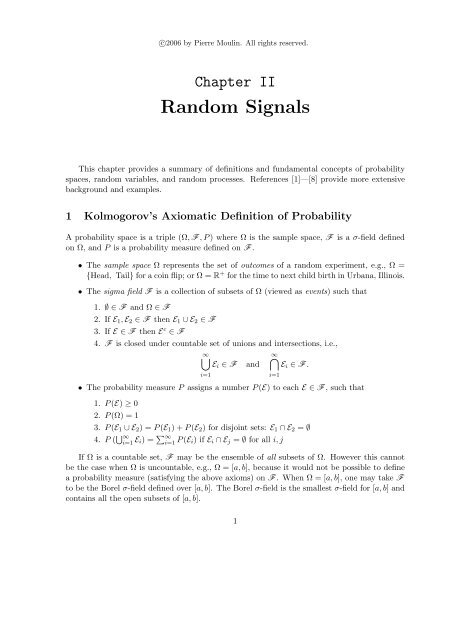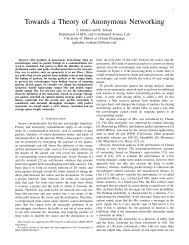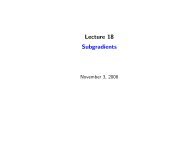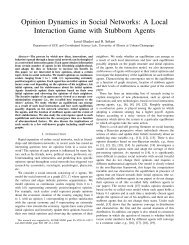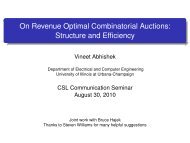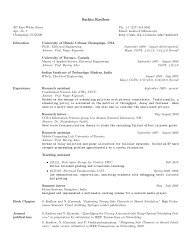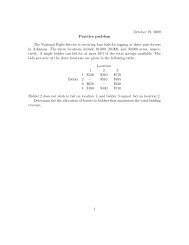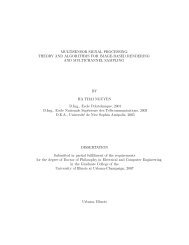Chapter 2: Random Signals - IFP Group at the University of Illinois
Chapter 2: Random Signals - IFP Group at the University of Illinois
Chapter 2: Random Signals - IFP Group at the University of Illinois
Create successful ePaper yourself
Turn your PDF publications into a flip-book with our unique Google optimized e-Paper software.
c○2006 by Pierre Moulin. All rights reserved.<br />
<strong>Chapter</strong> II<br />
<strong>Random</strong> <strong>Signals</strong><br />
This chapter provides a summary <strong>of</strong> definitions and fundamental concepts <strong>of</strong> probability<br />
spaces, random variables, and random processes. References [1]—[8] provide more extensive<br />
background and examples.<br />
1 Kolmogorov’s Axiom<strong>at</strong>ic Definition <strong>of</strong> Probability<br />
A probability space is a triple (Ω, F , P ) where Ω is <strong>the</strong> sample space, F is a σ-field defined<br />
on Ω, and P is a probability measure defined on F .<br />
• The sample space Ω represents <strong>the</strong> set <strong>of</strong> outcomes <strong>of</strong> a random experiment, e.g., Ω =<br />
{Head, Tail} for a coin flip; or Ω = R + for <strong>the</strong> time to next child birth in Urbana, <strong>Illinois</strong>.<br />
• The sigma field F is a collection <strong>of</strong> subsets <strong>of</strong> Ω (viewed as events) such th<strong>at</strong><br />
1. ∅ ∈ F and Ω ∈ F<br />
2. If E 1 , E 2 ∈ F <strong>the</strong>n E 1 ∪ E 2 ∈ F<br />
3. If E ∈ F <strong>the</strong>n E c ∈ F<br />
4. F is closed under countable set <strong>of</strong> unions and intersections, i.e.,<br />
∞⋃<br />
∞⋂<br />
E i ∈ F and E i ∈ F .<br />
i=1<br />
• The probability measure P assigns a number P (E) to each E ∈ F , such th<strong>at</strong><br />
1. P (E) ≥ 0<br />
2. P (Ω) = 1<br />
3. P (E 1 ∪ E 2 ) = P (E 1 ) + P (E 2 ) for disjoint sets: E 1 ∩ E 2 = ∅<br />
4. P ( ⋃ ∞<br />
i=1 E i) = ∑ ∞<br />
i=1 P (E i) if E i ∩ E j = ∅ for all i, j<br />
If Ω is a countable set, F may be <strong>the</strong> ensemble <strong>of</strong> all subsets <strong>of</strong> Ω. However this cannot<br />
be <strong>the</strong> case when Ω is uncountable, e.g., Ω = [a, b], because it would not be possible to define<br />
a probability measure (s<strong>at</strong>isfying <strong>the</strong> above axioms) on F . When Ω = [a, b], one may take F<br />
to be <strong>the</strong> Borel σ-field defined over [a, b]. The Borel σ-field is <strong>the</strong> smallest σ-field for [a, b] and<br />
contains all <strong>the</strong> open subsets <strong>of</strong> [a, b].<br />
1<br />
i=1
2 <strong>Random</strong> Variables<br />
Given a probability space (Ω, F , P ), we may formally define a real-valued random variable<br />
X as a measurable function from Ω to R, i.e.,<br />
{ω : X(ω) ≤ x} ∈ F , ∀x ∈ R.<br />
The cumul<strong>at</strong>ive distribution function (cdf) for X may <strong>the</strong>n be defined as<br />
F X (x) Pr[X ≤ x] = P ({ω : X(ω) ≤ x}).<br />
Observe th<strong>at</strong> for every Borel set B in R, <strong>the</strong> set {ω : X(ω) ∈ B} must correspond to an<br />
event E ∈ F , i.e., it must be in <strong>the</strong> domain <strong>of</strong> <strong>the</strong> probability function P (·). All sets <strong>of</strong> interest<br />
are unions or intersections <strong>of</strong> such sets.<br />
A cdf is nondecreasing, right-continuous, and s<strong>at</strong>isfies<br />
lim F X(x) = 0 and lim F X(x) = 1.<br />
x→−∞ x→∞<br />
Two types <strong>of</strong> random variables are <strong>of</strong>ten encountered in practice:<br />
• Discrete random variables, for which <strong>the</strong> probability <strong>of</strong> X is concentr<strong>at</strong>ed <strong>at</strong> a countable<br />
set <strong>of</strong> points {x i , i ∈ I}:<br />
P (X ∈ {x i , i ∈ I}) = 1.<br />
The cdf for discrete random variables is piecewise constant (staircase function). There<br />
is a jump <strong>at</strong> each point x i ; <strong>the</strong> amplitude <strong>of</strong> this jump is given by <strong>the</strong> probability mass<br />
function (pmf)<br />
p X (x i ) = P (X = x i ), i ∈ I.<br />
The pmf is nonneg<strong>at</strong>ive and sums to 1.<br />
• Continuous random variables, for which <strong>the</strong> cdf is <strong>the</strong> integral <strong>of</strong> a function:<br />
F X (x) =<br />
∫ x<br />
−∞<br />
f X (u)du<br />
The function f X is nonneg<strong>at</strong>ive and integr<strong>at</strong>es to one; f X is <strong>the</strong> probability density<br />
function (pdf) for X.<br />
O<strong>the</strong>r random variables are <strong>of</strong> a mixed discrete/continuous type, e.g., consider X = 0 with<br />
probability 1 2 and X is uniformly distributed over <strong>the</strong> interval [1, 2] with probability 1 2 .<br />
The m<strong>at</strong>hem<strong>at</strong>ical expect<strong>at</strong>ion <strong>of</strong> a random variable X is defined as<br />
∫<br />
EX x dF X (x)<br />
which may also be written as<br />
∫<br />
EX =<br />
R<br />
Ω<br />
ω dP (ω).<br />
These expressions simplify to <strong>the</strong> standard formulas EX = ∑ i∈I x i p X (x i ) and EX = ∫ x f X (x) dx<br />
for discrete and continuous random variables, respectively.<br />
2
3 Convergence <strong>of</strong> <strong>Random</strong> Sequences<br />
Let X n , 1 ≤ n < ∞, be a sequence <strong>of</strong> random variables indexed by <strong>the</strong> integer n. We are<br />
interested in <strong>the</strong> convergence property X n → X. For a deterministic sequence, we would use<br />
<strong>the</strong> classical definition: X n → X means th<strong>at</strong><br />
∀ɛ > 0, ∃n(ɛ) : |X n − X| < ɛ<br />
∀n > n(ɛ).<br />
For random sequences, <strong>the</strong> definition must involve <strong>the</strong> elements <strong>of</strong> Ω.<br />
3.1 Types <strong>of</strong> Convergence<br />
We shall encounter <strong>the</strong> following types <strong>of</strong> convergence:<br />
1. X n → X surely means<br />
lim X n(ω) = X ∀ω ∈ Ω.<br />
n→∞<br />
2. X n → X almost surely (with probability 1) means<br />
(<br />
)<br />
P lim X n(ω) = X = 1.<br />
n→∞<br />
3. X n → X in probability means<br />
4. X n → X in <strong>the</strong> mean square (m.s.) means<br />
5. X n → X surely means<br />
lim P (|X n(ω) − X| < ɛ) = 1.<br />
n→∞<br />
lim E|X n(ω) − X| 2 = 0.<br />
n→∞<br />
lim F n(x) = F (x) (pointwise on R)<br />
n→∞<br />
where F n and F are <strong>the</strong> distributions for X n and X, respectively.<br />
Convergence a.s. implies convergence surely.<br />
Convergence in probability implies convergence almost surely.<br />
Convergence in distribution implies convergence in probability and convergence m.s.<br />
3
3.2 Law <strong>of</strong> Large Numbers<br />
Let X i , 1 ≤ i < ∞ be i.i.d. random variables with mean µ and finite variance. Then <strong>the</strong><br />
sample average<br />
X n = 1 n∑<br />
X i<br />
n<br />
converges in probability to µ (weak law <strong>of</strong> large numbers); as well, X n converges a.s. to µ<br />
(strong law <strong>of</strong> large numbers).<br />
i=1<br />
3.3 Central Limit Theorem<br />
Let X i , 1 ≤ i < ∞ be i.i.d. random variables with mean µ and variance σ 2 . Then <strong>the</strong><br />
normalized sum<br />
Z n = 1 n∑<br />
σ √ (X i − µ)<br />
n<br />
converges to a normal distribution N (0, 1) in distribution.<br />
i=1<br />
A generaliz<strong>at</strong>ion <strong>of</strong> this problem is <strong>the</strong> case <strong>of</strong> variable components. Let X i , 1 ≤ i < ∞ be<br />
independent random variables with common mean µ but unequal variances σ 2 i , 1 ≤ i < ∞ [2,<br />
p. 213] [7, p. 518]. Define <strong>the</strong> sum <strong>of</strong> variances<br />
S 2 n =<br />
n∑<br />
σi 2 .<br />
i=1<br />
Then <strong>the</strong> normalized sum<br />
Z n = 1<br />
S n<br />
n∑<br />
(X i − µ)<br />
i=1<br />
converges to a normal distribution N (0, 1) in distribution if Lindeberg’s conditions are s<strong>at</strong>isfied:<br />
∀ɛ > 0, ∃n(ɛ) :<br />
σ i<br />
S n<br />
< ɛ ∀n > n(ɛ), i = 1, · · · , n.<br />
We may interpret <strong>the</strong> r<strong>at</strong>io σ i /S n as <strong>the</strong> contribution <strong>of</strong> component i to <strong>the</strong> weighted sum<br />
Z n . For <strong>the</strong> CLT to apply, Z n must be sum <strong>of</strong> many asymptotically negligible components.<br />
One component is not allowed to domin<strong>at</strong>e <strong>the</strong> sum.<br />
4 <strong>Random</strong> Processes<br />
Definition: A random process is a collection <strong>of</strong> random variables {X(t), t ∈ T }, where T is<br />
<strong>the</strong> index set.<br />
4
Usually T is not a finite set. We shall distinguish between <strong>the</strong> case where T is a countable<br />
index set, e.g., {0, 1}, Z, and Z d , or an uncountable set, such as an interval on <strong>the</strong> real line.<br />
One difficulty th<strong>at</strong> arises when |T | = ∞ is th<strong>at</strong> <strong>the</strong> notion <strong>of</strong> pdf breaks down. Moreover,<br />
<strong>the</strong> definition <strong>of</strong> infinite-dimensional cdf’s requires care.<br />
Let us start with finite-dimensional cdf’s. The definition <strong>of</strong> one-dimensional cdf’s,<br />
is n<strong>at</strong>urally extended to two dimensions:<br />
and to any finite number n <strong>of</strong> dimensions:<br />
F t (x) = P [X(t) ≤ x]<br />
F t1 ,t 2<br />
(x 1 , x 2 ) = P [X(t 1 ) ≤ x 1 , X(t 2 ) ≤ x 2 ]<br />
F t1 ,··· ,t n<br />
(x 1 , · · · , x n ) = P [X(t 1 ) ≤ x 1 , · · · , X(t n ) ≤ x n ].<br />
This defines a hierarchy <strong>of</strong> multidimensional cdf’s <strong>of</strong> all orders. They must s<strong>at</strong>isfy <strong>the</strong> comp<strong>at</strong>ibility<br />
conditions<br />
lim F t<br />
x 2 →∞ 1 ,t 2<br />
(x 1 , x 2 ) = F t1 (x 1 ), etc.<br />
In practice, fortun<strong>at</strong>ely, <strong>the</strong>re exist simple mechanisms for gener<strong>at</strong>ing probability distributions.<br />
4.1 Kolmogorov’s Extension Theorem<br />
Having defined finite-dimensional distributions, we need extend this concept to <strong>the</strong> whole index<br />
set T . Formally, we need to specify a probability space (Ω T , F T , P T ) th<strong>at</strong> is comp<strong>at</strong>ible with<br />
all finite-dimensional probability spaces (Ω n , F n , P n ). If T is countable (say N), F T is <strong>the</strong><br />
smallest σ-field <strong>of</strong> subsets <strong>of</strong> R T containing all finite-dimensional rectangles [4, p. 21].<br />
The existence <strong>of</strong> such a probability space (Ω T , F T , P T ) is guaranteed by Kolmogorov’s<br />
Extension Theorem [5, p. 16] [4, p. 24]. Fur<strong>the</strong>rmore, this extension is unique when T is<br />
countable.<br />
Examples (with T = Z 2 )<br />
• x(n 1 , n 2 ) = i.i.d. random variables (sp<strong>at</strong>ially white noise)<br />
• x(n 1 , n 2 ) ≡ A where A is a random variable<br />
• x(n 1 , n 2 ) ∈ {0, 1}: binary random field<br />
5
4.2 Uncountable Index Set<br />
When <strong>the</strong> index T is countable, we may conceptually obtain <strong>the</strong> entire sample p<strong>at</strong>h <strong>of</strong> <strong>the</strong><br />
random process by observing its samples for all values <strong>of</strong> t (we can “count” <strong>the</strong>se samples).<br />
However, technical difficulties arise when T is uncountably infinite, e.g., T = [a, b]. Intuitively,<br />
<strong>the</strong> collection <strong>of</strong> random variables {X(t), t ∈ T } may be “too large” and cannot be recovered<br />
by sampling. Such is <strong>the</strong> case, for instance, when T = R and X(t), t ∈ T , are i.i.d. samples.<br />
A simple example is <strong>the</strong> process X(t), t ∈ [0, 1], th<strong>at</strong> is gener<strong>at</strong>ed as follows: pick a random<br />
variable t 0 from <strong>the</strong> uniform distribution on [0, 1] and let X(t) = 0 <strong>at</strong> all points except <strong>at</strong> t = t 0 ,<br />
where X(t) = 1. This process is st<strong>at</strong>istically indistinguishable from <strong>the</strong> trivial process ˜X(t) ≡ 0<br />
in <strong>the</strong> following sense. The n-dimensional cdf’s for <strong>the</strong> processes X and ˜X are identical for all<br />
values <strong>of</strong> n. Heuristically speaking, we may collect an arbitrary large number <strong>of</strong> samples <strong>of</strong> X,<br />
yet with probability 1 <strong>the</strong>y will all have value 0, i.e., coincide with those for <strong>the</strong> process ˜X.<br />
In measure-<strong>the</strong>oretic terms, when T is uncountably infinite, Kolmogorov’s extension is not<br />
necessarily unique. This difficulty does not arise when <strong>the</strong> random process is “continuous<br />
enough” th<strong>at</strong> specifying all finite-order cdf’s completely characterizes <strong>the</strong> distribution <strong>of</strong> <strong>the</strong><br />
process. Such processes can be “sampled” and are said to be separable. Fortun<strong>at</strong>ely, all random<br />
processes <strong>of</strong> interest to us are in <strong>the</strong> c<strong>at</strong>egory. The example given above describes a processes<br />
X th<strong>at</strong> is not separable because not “continuous enough”.<br />
4.3 Moments <strong>of</strong> a <strong>Random</strong> Process<br />
The moments <strong>of</strong> a real-valued random process include<br />
• <strong>the</strong> mean µ X (t), t ∈ T , where µ X (t) EX(t);<br />
• <strong>the</strong> correl<strong>at</strong>ion function R X (t 1 , t 2 ), t 1 , t 2 ∈ T , where R X (t 1 , t 2 ) = E[X(t 1 )X(t 2 )];<br />
• <strong>the</strong> covariance function C X (t 1 , t 2 ) = R X (t 1 , t 2 ) − µ X (t 1 )µ X (t 2 ), which is <strong>the</strong> correl<strong>at</strong>ion<br />
function for <strong>the</strong> centered process X(t)µ X (t);<br />
• <strong>the</strong> n-th order moment E[X(t 1 ) · · · X(t n )].<br />
The covariance function is symmetric and positive semidefinite, i.e., <strong>the</strong> n×n m<strong>at</strong>rix {R X (t i , t j ), 1 ≤<br />
i, j ≤ n} is positive semidefinite for all choices <strong>of</strong> n-tuples {t i }. A process is said to be a secondorder<br />
process if EX 2 (t) = R X (t, t) < ∞ for all t.<br />
4.4 Gaussian <strong>Random</strong> Process<br />
Define a mean function µ X (t), t ∈ T and a continuous covariance function C X (t 1 , t 2 ). Let<br />
F t1 ,··· ,t n<br />
(x 1 , · · · , x n ) be <strong>the</strong> classical n-dimensional distribution with mean vector {µ X (t 1 ), · · · , µ X (t n )}<br />
and covariance m<strong>at</strong>rix {C X (t i , t j ), 1 ≤ i, j ≤ n}. This defines a hierarchy <strong>of</strong> multidimensional<br />
distributions, and <strong>the</strong> consistency conditions are autom<strong>at</strong>ically s<strong>at</strong>isfied. Note <strong>the</strong> simplicity<br />
<strong>of</strong> this construction.<br />
6
5 St<strong>at</strong>ionary Processes<br />
A st<strong>at</strong>ionary process is a random process whose st<strong>at</strong>istical properties do not change over<br />
time/space. Formally, <strong>the</strong> process X(t), t ∈ T , is said to be st<strong>at</strong>ionary if<br />
F t1 +τ,··· ,t n +τ (x 1 , · · · , x n ) = F t1 ,··· ,t n<br />
(x 1 , · · · , x n )<br />
∀{t i , x i } ∈ T n × R n , ∀τ ∈ T , ∀n.<br />
The index set might be discrete or continuous time (T = R or Z, respectively) or d-dimensional<br />
space (T = R d or Z d ).<br />
A wide-sense st<strong>at</strong>ionary (WSS) process s<strong>at</strong>isfies a similar invariance properties in terms <strong>of</strong><br />
its first two moments:<br />
µ X (t) = µ X , ∀t ∈ T<br />
R X (t 1 , t 2 ) = R X (t 1 − t 2 ), ∀t 1 , t 2 ∈ T .<br />
St<strong>at</strong>ionarity implies wide-sense st<strong>at</strong>ionarity, but <strong>the</strong> converse is not true. A WSS process is<br />
also called weakly st<strong>at</strong>ionary.<br />
When <strong>the</strong> index set for a WSS random process X is R d or Z d where d ≥ 1, we define <strong>the</strong><br />
spectral density <strong>of</strong> X as<br />
S X (f) = F[C X ](f)<br />
where f is a d-dimensional frequency vector, and F denotes <strong>the</strong> appropri<strong>at</strong>e d-dimensional<br />
Fourier transform. When T = R d , we have <strong>the</strong> Fourier transform pair<br />
∫<br />
S X (f) = C X (t)e −j2πf·t dt, f ∈ R d<br />
R<br />
∫<br />
d<br />
C X (t) = S X (f)e j2πf·t df, t ∈ R d<br />
R d<br />
where f · t denotes <strong>the</strong> dot product <strong>of</strong> <strong>the</strong> respective d-vectors. When T = Z d , we have<br />
S X (f) = ∑ i∈Z d C X (i)e −j2πf·i , f ∈<br />
C X (t) =<br />
∫<br />
[<br />
− 1 2 , 1 ] d<br />
2<br />
[− 1 2 , 1 2] d S X(f)e j2πf·t df, t ∈ Z d .<br />
The (d-dimensional) spectral density represents <strong>the</strong> average distribution <strong>of</strong> energy across frequency.<br />
The spectral density is nonneg<strong>at</strong>ive (as proven by Herglotz (1911) for T = Z and by<br />
Bochner (1932) for T = R). Existence <strong>of</strong> <strong>the</strong> spectral density is guaranteed if ∫ |C X | < ∞ (in<br />
<strong>the</strong> case T = R d ) or ∑ i |C X(i)| < ∞ (in <strong>the</strong> case T = Z d ).<br />
7
6 Isotropic Processes<br />
Let T = R d or Z d . A d-dimensional isotropic process is a st<strong>at</strong>ionary process whose correl<strong>at</strong>ion<br />
function R X (t) is spherically symmetric:<br />
R X (t) = R X (‖t‖)<br />
where ‖ · ‖ denotes Euclidean norm. By <strong>the</strong> elementary properties <strong>of</strong> <strong>the</strong> Fourier transform,<br />
isotropy implies th<strong>at</strong> <strong>the</strong> spectral density is also spherically symmetric:<br />
S X (f) = S X (‖f‖).<br />
Isotropic models are frequently used in image processing.<br />
7 Wide-Sense Periodic Processes<br />
A d-dimensional random process X(t), t ∈ T is wide-sense periodic if its mean function µ X (t)<br />
and its correl<strong>at</strong>ion function C X (t 1 , t 2 ) s<strong>at</strong>isfy <strong>the</strong> following properties:<br />
1. µ X (t) = µ X (t + T i ) for i = 1, · · · , d, where T 1 , · · · , T d are d periodicity vectors.<br />
2. C X (t 1 , t 2 ) = C X (t 1 + T i , t 2 ) = C X (t 1 , t 2 + T i ) for i = 1, · · · , d.<br />
For a wide-sense periodic process, it may be shown th<strong>at</strong><br />
E|X(t + T i ) − X(t)| 2 = 0 ∀t ∈ T , i = 1, · · · , d,<br />
i.e., <strong>the</strong> realiz<strong>at</strong>ions <strong>of</strong> this process are “mean-square periodic”.<br />
8 Continuity <strong>of</strong> <strong>Random</strong> Processes<br />
Let X(t), t ∈ R d be a second-order random process. The process is said to be mean-square<br />
(m.s.) continuous <strong>at</strong> t if<br />
lim X(s) = X(t) m.s.<br />
s→t<br />
i.e., E|X(t) − X(s)| 2 m.s. → 0 as s → t. One may similarly define processes th<strong>at</strong> are continuous in<br />
probability, or in distribution, by replacing <strong>the</strong> m.s. limit by <strong>the</strong> appropri<strong>at</strong>e limit.<br />
None <strong>of</strong> this implies th<strong>at</strong> <strong>the</strong> sample p<strong>at</strong>hs <strong>of</strong> <strong>the</strong> process X are continuous. For instance,<br />
define <strong>the</strong> following process: pick two independent random variables A and t 0 according to a<br />
normal distribution, and let<br />
{ A : t < t0<br />
X(t) =<br />
A + 1 : t ≥ t 0 .<br />
8
Any sample p<strong>at</strong>h <strong>of</strong> this process has one point <strong>of</strong> discontinuity (<strong>at</strong> <strong>the</strong> random loc<strong>at</strong>ion t 0 ).<br />
Yet it can be verified th<strong>at</strong> X is m.s. continuous everywhere.<br />
The notion <strong>of</strong> a.s. continuity <strong>of</strong> a random process is quite different from <strong>the</strong> three notions<br />
discussed above. A random process is a.s. continuous if <strong>the</strong> probability th<strong>at</strong> a sample p<strong>at</strong>h is<br />
continuous is 1. The process X in our example above fails th<strong>at</strong> stronger condition, because<br />
<strong>the</strong> probability th<strong>at</strong> a sample p<strong>at</strong>h is continuous is 0.<br />
The notion <strong>of</strong> m.s. continuity is useful in part because th<strong>at</strong> property can be inferred by<br />
inspection <strong>of</strong> <strong>the</strong> correl<strong>at</strong>ion function. Indeed <strong>the</strong> following three properties are equivalent:<br />
1. X is m.s. continuous<br />
2. R X (t, s) is continuous over T × T<br />
3. R X (t, t) is continuous <strong>at</strong> all t ∈ T .<br />
For a WSS process, <strong>the</strong> correl<strong>at</strong>ion function is <strong>of</strong> <strong>the</strong> form R X (t), t ∈ T , and <strong>the</strong> following<br />
three properties are equivalent:<br />
1. X is m.s. continuous<br />
2. R X (t) is continuous over T<br />
3. R X (t) is continuous <strong>at</strong> t = 0.<br />
9 Stochastic Integrals<br />
We <strong>of</strong>ten deal with random processes th<strong>at</strong> are outputs <strong>of</strong> linear systems, e.g.,<br />
∫<br />
Y (t) = X(s)h(t − s) ds, t ∈ R d .<br />
R d<br />
Since X depends on <strong>the</strong> outcome ω <strong>of</strong> <strong>the</strong> random experiment, this integral may not always<br />
exist. Wh<strong>at</strong> meaning can we <strong>at</strong>tach to such an integral?<br />
Let us consider <strong>the</strong> following generic problem. Denote by I <strong>the</strong> integral ∫ Λ<br />
X(t) dt, where<br />
Λ ⊂ T . Define a set <strong>of</strong> intervals {∆ i , 1 ≤ i ≤ n} th<strong>at</strong> form a partition <strong>of</strong> Λ, i.e.,<br />
∞⋃<br />
∆ i = Λ, ∆ i ∩ ∆ j = ∅ ∀i ≠ j.<br />
i=1<br />
Assume th<strong>at</strong> max i |∆ i | → 0 as n → ∞. Choose some t i in each interval ∆ i and define <strong>the</strong> sum<br />
I n =<br />
n∑<br />
X(t i )|∆ i |.<br />
i=1<br />
9
For a classical (Riemann) integral, we have I lim n→∞ I n .<br />
For a stochastic integral, <strong>the</strong> mean-square integral I exists when<br />
lim E(I − I n) 2 = 0,<br />
n→∞<br />
i.e., I n<br />
m.s.<br />
→ I.<br />
Properties <strong>of</strong> <strong>the</strong> mean-square integral.<br />
• Existence: guaranteed if ∫ ∫<br />
Λ Λ R X(t, s) dt ds < ∞;<br />
∫ ∫ ∫ ∫ ∫<br />
• Linearity: [aX(t) + bY (t)] dt = a X(t) dt + b Y (t) dt provided th<strong>at</strong> X and Y<br />
exist;<br />
• Moments: E[ ∫ X(t) dt] = ∫ E[X(t)] dt and E( ∫ X(t) dt) 2 = ∫ ∫ R X (t, s) dt ds .<br />
LSI Filtering. Consider a Linear Shift Invariant (LSI) system with impulse response h(t),<br />
and denote by R h (u) ∫ h(t)h(t + u) dt <strong>the</strong> deterministic autocorrel<strong>at</strong>ion function <strong>of</strong> h. If <strong>the</strong><br />
process X(t), t ∈ R d is input to this sytem, <strong>the</strong> output is<br />
∫<br />
Y (t) = X(s)h(t − s) ds, t ∈ R d<br />
R d ∫<br />
∫<br />
µ Y (t) = EY (t) = EX(s)h(t − s) ds = µ X (s)h(t − s) ds<br />
R Y (t, s) = E[Y (t)Y (s)]<br />
[∫<br />
∫<br />
]<br />
= E X(t ′ )h(t − t ′ ) dt ′ X(s ′ )h(s − s ′ ) ds ′<br />
∫ ∫<br />
= E[X(t ′ )X(s ′ )]h(t − t ′ )h(s − s ′ ) dt ′ ds ′<br />
∫ ∫<br />
= R X (t ′ , s ′ )h(t − t ′ )h(s − s ′ ) dt ′ ds ′ .<br />
If <strong>the</strong> process X is WSS, <strong>the</strong>se expressions simplify to<br />
µ Y (t) = µ X<br />
∫<br />
h(t) dt<br />
R Y (t − s) = (R X ⋆ R h )(t − s).<br />
Special Case: Filtering white noise X(t) through a LSI system.<br />
Taking R X (t) = δ(t), we obtain<br />
R Y (t) = (R X ⋆ R h )(t) = R h (t).<br />
The stochastic m.s. integral Y (t) = ∫ X(s)h(t − s) ds exists if R h (0) = ∫ |h(t)| 2 dt < ∞.<br />
Compare with <strong>the</strong> traditional Bounded Input Bounded Output (BIBO) condition for stability<br />
<strong>of</strong> LSI systems: ∫ |h(t)| dt < ∞. Which condition is stronger?<br />
10
Note th<strong>at</strong> “white noise” on R is not a separable process, but <strong>the</strong> filtered noise is a separable<br />
process. We could have been more careful in <strong>the</strong> deriv<strong>at</strong>ion above and selected a separable<br />
process X ɛ as <strong>the</strong> input, where X ɛ becomes “white noise” as ɛ → 0. Specifically, choose<br />
some correl<strong>at</strong>ion function R(t), continuous <strong>at</strong> t = 0 and integr<strong>at</strong>ing to 1, and define R(t; ɛ) <br />
ɛ −1 R(ɛ −1 t) which forms a resolution <strong>of</strong> <strong>the</strong> identity:<br />
∫<br />
∫<br />
f(t)δ(t) dt lim f(t)R(t; ɛ) dt = f(0)<br />
ɛ→0<br />
for any function f th<strong>at</strong> is continuous <strong>at</strong> t = 0. Then if a WSS process X ɛ with correl<strong>at</strong>ion<br />
function R(t; ɛ) is input to <strong>the</strong> LSI system, <strong>the</strong> correl<strong>at</strong>ion function <strong>of</strong> <strong>the</strong> output is given by<br />
R h (t) in <strong>the</strong> limit as ɛ → 0.<br />
10 Ergodic Processes<br />
Let T = R d or Z d . In practice a st<strong>at</strong>istical description <strong>of</strong> images (or any o<strong>the</strong>r random process)<br />
is not available, so <strong>the</strong>se quantities have to be estim<strong>at</strong>ed from <strong>the</strong> d<strong>at</strong>a. Consider for instance<br />
<strong>the</strong> problem <strong>of</strong> estim<strong>at</strong>ing <strong>the</strong> mean µ <strong>of</strong> a st<strong>at</strong>ionary random process given d<strong>at</strong>a X(t), t ∈ Λ.<br />
The mean can be estim<strong>at</strong>ed using <strong>the</strong> stochastic integral<br />
ˆµ = 1<br />
|Λ|<br />
∫<br />
Λ<br />
X(t) dt.<br />
In many cases, ˆµ → µ as |Λ| → ∞. (Example: sp<strong>at</strong>ially white noise) In this case, <strong>the</strong> process<br />
X(t) is said to be ergodic in <strong>the</strong> mean. Formally:<br />
Definition: A WSS process X(t), t ∈ T , is (m.s.) ergodic in <strong>the</strong> mean iff<br />
Wh<strong>at</strong> does it take to have ergodicity?<br />
ˆµ m.s. → µ as |Λ| → ∞.<br />
Intuitively, ˆµ should be an average <strong>of</strong> many independent observ<strong>at</strong>ions (so th<strong>at</strong> a law <strong>of</strong><br />
large numbers type result applies). This means th<strong>at</strong> X(t) should decorrel<strong>at</strong>e rapidly, i.e., <strong>the</strong><br />
“correl<strong>at</strong>ion area” should be small enough.<br />
Example #1 (Worst-case scenario): X(t) = A (random variable) for all t ∈ T . Then<br />
ˆµ = A no m<strong>at</strong>ter how large <strong>the</strong> observ<strong>at</strong>ion window Λ is, and ˆµ does not converge to µ.<br />
Example #2 X(t) = A cos(2πt) for all t ∈ T . For a symmetric window Λ = [−n−τ, n+τ]<br />
2A sin(2πτ)<br />
where n ∈ N and τ ∈ [0, 1), we obtain ˆµ =<br />
|Λ|<br />
which vanishes as |Λ| → ∞.<br />
The expected value <strong>of</strong> ˆµ is given by<br />
Eˆµ = 1 ∫<br />
EX(t) dt = µ,<br />
|Λ|<br />
Λ<br />
11
i.e., ˆµ is an unbiased estim<strong>at</strong>or <strong>of</strong> µ. The variance <strong>of</strong> ˆµ is given by<br />
E(ˆµ − µ) 2 = 1 ∫<br />
|Λ|<br />
∫Λ<br />
2 EC X (t − t ′ ) dt dt ′ .<br />
Λ<br />
If this variance vanishes as |Λ| → ∞, we say th<strong>at</strong> <strong>the</strong> estim<strong>at</strong>or ˆµ is m.s. consistent.<br />
Slutskys Ergodic Theorem [Yaglom, p. 218]: X is ergodic in <strong>the</strong> mean iff<br />
∫<br />
1<br />
C X (t) dt → 0 as |Λ| → ∞<br />
|Λ|<br />
Λ<br />
The condition above is certainly s<strong>at</strong>isfied if C X (t) → 0 as |t| → ∞ or even if C X (t) contains<br />
sinusoidal components (as in <strong>the</strong> case <strong>of</strong> periodic processes such as X in Example #2 above).<br />
But C X (t) should not contain a d.c. component, which implies th<strong>at</strong> S X (f) may not contain<br />
an impulse <strong>at</strong> f = 0! (as in Example #1 above).<br />
O<strong>the</strong>r types <strong>of</strong> ergodicity can be defined similarly. For instance:<br />
Definition: A WSS process X is ergodic in correl<strong>at</strong>ion <strong>at</strong> <strong>the</strong> shift s if<br />
ˆR X (s) → R X (s)<br />
m.s. as |Λ| → ∞<br />
where<br />
ˆR X (s) = 1 ∫<br />
X(t + s)X(t) dt.<br />
|Λ| Λ<br />
Definition: A WSS process X is ergodic in correl<strong>at</strong>ion if <strong>the</strong> condition above holds for all<br />
shifts.<br />
Analysis <strong>of</strong> ergodicity conditions is similar to analysis for ergodicity in <strong>the</strong> mean, where<br />
<strong>the</strong> variance <strong>of</strong> ˆR X (s) should tend to zero as |Λ| → 0.<br />
For Gaussian processes we have <strong>the</strong> following result [5, p. 136].<br />
Theorem (Maruyama 1949). Let X be a real, st<strong>at</strong>ionary, Gaussian process with continuous<br />
covariance function. Then X is ergodic ⇔ S X (f) is continuous.<br />
Examples <strong>of</strong> ergodic processes<br />
1. {X(t), t ∈ Z 2 } = i.i.d. random variables (sp<strong>at</strong>ially white noise)<br />
2. Y (t) = (X ⋆ h)(t) where X is as above, and h is FIR.<br />
3. Y (t) = (X ⋆ h)(t) where X is as above, and ‖h‖ < ∞ (possibly IIR filter)<br />
12
11 <strong>Random</strong> Processes on <strong>the</strong> Sphere<br />
[3, Ch. 22.5] [5, p. 129] [Grenander, 1963]<br />
Let T be <strong>the</strong> unit sphere in R 3 . A random process X(t), t ∈ T , may be thought <strong>of</strong> as<br />
an image defined on <strong>the</strong> sphere. This type <strong>of</strong> imagery is encountered in 3-D imaging (e.g.,<br />
electric surface fields and imaging <strong>of</strong> planets. Moreover, 3-D scenes are <strong>of</strong>ten represented using<br />
spherical projections.<br />
The figure below depicts <strong>the</strong> unit sphere in R 3 . A point t on <strong>the</strong> sphere may be represented<br />
using two angles: <strong>the</strong> l<strong>at</strong>itude θ ∈ [0, π] and <strong>the</strong> longitude ψ ∈ [0, 2π].<br />
Z<br />
θ<br />
t<br />
ψ<br />
X<br />
For 2-D images, <strong>the</strong> notion <strong>of</strong> st<strong>at</strong>ionarity implies th<strong>at</strong> images are defined over infinite<br />
planar domains, but th<strong>at</strong> assumption is clearly artificial. Modeling images as wide-sense periodic<br />
processes, as discussed earlier, is a possible solution. The represent<strong>at</strong>ion <strong>of</strong> images as<br />
random fields defined on <strong>the</strong> sphere is a useful altern<strong>at</strong>ive because one may view such images<br />
as projections <strong>of</strong> a physical 3-D image.<br />
Now, how can we define st<strong>at</strong>ionary and isotropic processes on <strong>the</strong> sphere?<br />
On <strong>the</strong> sphere, st<strong>at</strong>ionarity and isotropicity mean invariance to rot<strong>at</strong>ions:<br />
• EX(t) = µ X is independent <strong>of</strong> t;<br />
• E[X(t)X(s)] = R X (t, s) = R X (φ) where φ is <strong>the</strong> spherical angle (a distance) between t<br />
and s.<br />
The general form <strong>of</strong> a nonneg<strong>at</strong>ive definite kernel R X (t, s) th<strong>at</strong> depends on t and s only via φ<br />
13
is as follows [Grenander p. 130]:<br />
R X (φ) =<br />
S X (m) =<br />
∞∑<br />
S X (m)P m (cos φ)<br />
m=0<br />
∫<br />
sphere<br />
R X (φ)P m (cos φ) dt<br />
where S X (m) ≥ 0, and P m (·) are Legendre polynomials. These expressions are reminiscent <strong>of</strong><br />
<strong>the</strong> Fourier transform formulas, except th<strong>at</strong> <strong>the</strong> basis functions are not complex exponentials<br />
but Legendre polynomials.<br />
12 <strong>Random</strong> Processes on Arbitrary Algebraic Structures<br />
We have studied random processes whose correl<strong>at</strong>ion function R X (t, s) is invariant to shifts<br />
(in Z d and R d ) and rot<strong>at</strong>ions (on <strong>the</strong> sphere). Can this be fur<strong>the</strong>r generalized?<br />
The answer is positive if we consider an index set T with group structure [6]. One can<br />
<strong>the</strong>n introduce <strong>the</strong> concept <strong>of</strong> invariance to <strong>the</strong> group oper<strong>at</strong>ion (e.g., transl<strong>at</strong>ion or rot<strong>at</strong>ion)<br />
and define a spectral density which is a Fourier transform defined on <strong>the</strong> group. The “basis<br />
functions” for such Fourier transforms are group characters γ(t) which s<strong>at</strong>isfy <strong>the</strong> property<br />
γ(t 1 + t 2 ) = γ(t 1 ) + γ(t 2 ).<br />
References<br />
[1] B. Hajek, Notes for ECE534: An Explor<strong>at</strong>ion <strong>of</strong> <strong>Random</strong> Processes for Engineers, available<br />
from http://www.ifp.uiuc.edu/˜hajek/Papers/randomprocJuly06.pdf, 2006.<br />
[2] H. Stark and J. W. Woods, Probability, <strong>Random</strong> Processes, and Estim<strong>at</strong>ion Theory for<br />
Engineers, Prentice-Hall, Upper Saddle River, NJ, 1994.<br />
[3] A. M. Yaglom, Correl<strong>at</strong>ion Theory <strong>of</strong> St<strong>at</strong>ionary and Rel<strong>at</strong>ed <strong>Random</strong> Functions I: Basic<br />
Results, Springer-Verlag, 1987.<br />
[4] L. Breiman, Probability, SIAM, 1992.<br />
[5] U. Grenander, Abstract Inference, Wiley, New York, 1981.<br />
[6] U. Grenander, Probabilities on Algebraic Structures, Wiley, New York, 1963.<br />
[7] W. Feller, An Introduction to Probability Theory and Its Applic<strong>at</strong>ions, Wiley, New York,<br />
1971.<br />
[8] J. Doob, Stochastic Processes, Wiley, 1953.<br />
14


